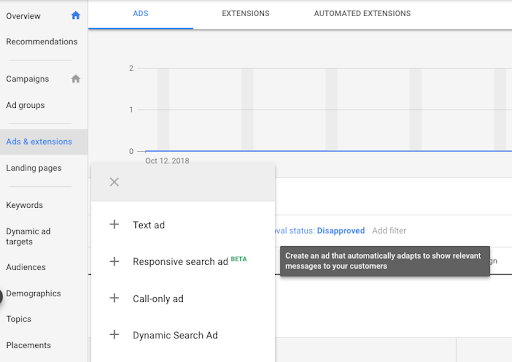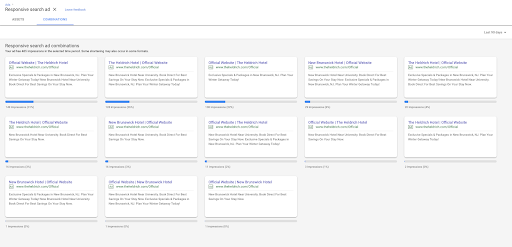
In May of 2018, Google introduced a new ad format beta: the responsive search ad.This text ad dynamically combines headlines and descriptions to achieve an advertiser’s goal. You will find this ad format when you create a new ad in any search campaign.The advertisement types are using Google’s machine learning to help deliver the most relevant ad for a users search query – and they are taking up more SERP real estate.

When it comes to Responsive Search Ads, advertisers have the ability to add up to 15, 30-character headlines and four, 90-character descriptions.Are there headlines or descriptions you want to be displayed more often than others? No problem. In this format, you have the ability to “pin” certain headlines or descriptions in specific positions, depending on your preference.

Not only are the number of headline and description combinations more than what we are used to, but Google has also introduced a new, automated”feedback tool”. When writing responsive search ads, the headline or description field is auto-populated based on copy you have used in other ads.The ad strength indicator in the top right evaluates the ad as it is written and predicts how effective your ad will be. Your ad strength can be one of four options: poor, average, good, or excellent. While this feature is great, we are still testing and analyzing its relevance and effect. We’ve noticed Google wants a certain amount of headline and description combinations in order to determine that an ad is “above average”, however, we are not necessarily seeing that this increase in combinations improves the performance of our ads.Once an ad has been running for a while, you can see the top combinations of headlines and descriptions by visiting the ad section of your campaign and clicking on “View Asset Details” in blue under the ad copy. If you don’t see this option, it means the ad needs to run longer to develop this information.Click on “Combinations” near the top left and you’ll be able to see which combinations of headlines and descriptions in a specific order get the most clicks based on the number of impressions the ad served.

Our Results
We’ve done a bit of work with testing and utilizing the new features of this beta – but we don’t necessarily consider it a “win” or digital marketing game-changer just yet – it’s certainly still in beta for a reason – but definitely something new to try out for yourself.We haven’t noticed huge changes in performance specifically because of this new ad format to date. It has, though, made our process somewhat more efficient in terms of creating multiple ad variations more quickly – and then allowing Google to optimize the delivery based on search terms and user intent, which takes the guess work out.In terms of our responsive ad testing, we believe that (regardless of how many headlines) Google is clearly favoring this ad type right now – not because its necessarily performing better – but because Google may want to just be gathering as much data as they can in their beta of this feature to assess next steps and improvements.Overall, we haven’t seen huge changes in engagement metrics.It has also become clear to us that because there are so many variations – you must have a large search volume in order for Google to optimize delivery and really move the needle for this effort.
Best Practices
From testing across a variety of clients, these are what we recommend for using this ad format:
- Mix copy that performs well with new headlines and descriptions to gather insights on what users like to see in an ad
- Create an experiment to test expanded text ads vs. responsive text ads. (this feature was not available when this beta originally came out, but now it is)
- If all your offers are on one page, use this ad format to push all the available packages to see which packages your audience finds more enticing
Conclusion
So, the question remains: does this replace expanded text ads? We say… it depends.Unless you have the appropriate search volume for the account you’d like to try this ad format with, we don’t recommend you test it immediately.If your account has plenty of search volume, we encourage you to test this. Don’t worry, your statistics won’t change drastically because you are testing this new feature. In fact, personalizing the ad may just get you more SERP real estate and will certainly be more enticing to the user in the end.
Did you enjoy the read?
Get original hospitality industry insights delivered to your inbox. Sign up to receive Screen Pilot’s #TrendingNow Newsletter.






